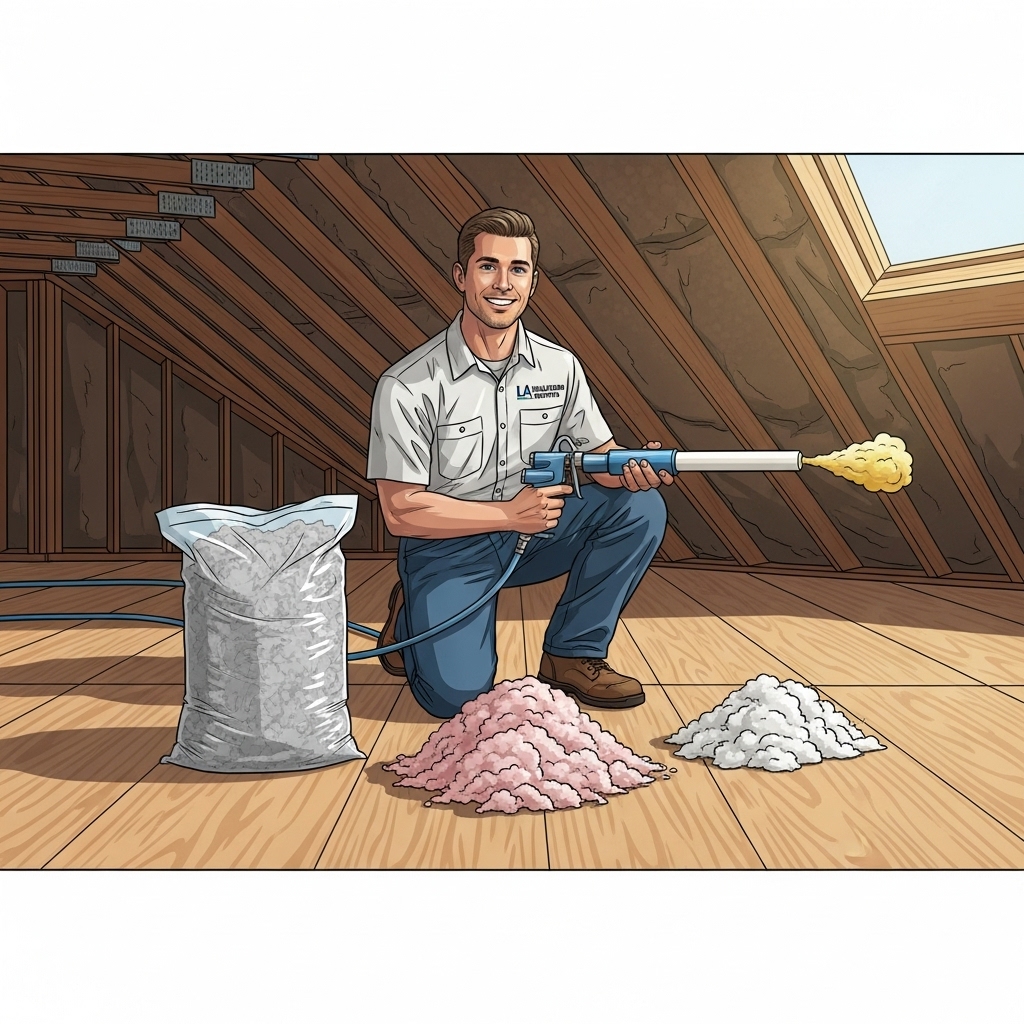Ask ten Los Angeles homeowners what “best attic insulation” means and you’ll hear a range of priorities: cooler bedrooms during summer heat, quieter living spaces, healthier indoor air, and a retrofit that doesn’t disrupt day-to-day life. The beauty of our climate is that it rewards a thoughtful balance of materials and methods. While winters are mild, summer sun can turn attics into ovens, and evening temperature drops ask for a thermal blanket that holds steady. Choosing the best approach for your home is about marrying material performance with careful preparation. When we talk about the best options, we’re really talking about a system—air sealing, ventilation, and the right depth of attic insulation working together to keep your rooms comfortable year-round.
Los Angeles architecture is a tapestry of eras and styles, and each type of home nudges the insulation strategy in a slightly different direction. A 1920s bungalow might have low-clearance eaves and irregular framing that favor blown-in materials. A mid-century ranch often presents broad spans where a uniform blanket delivers excellent results. Contemporary homes can include complex rooflines and skylight wells that demand careful detailing. What’s common to all is the principle that a smooth, continuous insulation layer paired with diligent air sealing turns a good material into a great outcome.
Blown-in cellulose: cohesive coverage with acoustic benefits
Blown-in cellulose is a workhorse in Los Angeles attics. Its density and small particle size allow it to settle into nooks around wiring and plumbing, delivering a cohesive layer with very few voids. Homeowners often notice the added quiet as much as the thermal change, since cellulose does an admirable job at damping sound. Properly installed to the target depth, it achieves the R-value you need and resists wind washing when protected by eave baffles.
Cellulose’s ability to fill irregular spaces shines in older homes where framing is anything but standard. It also pairs nicely with an “over-blanket” strategy when there are existing batts; the new layer smooths over seams and inconsistencies to produce a more uniform thermal boundary. As with any loose-fill product, quality control comes from depth markers, consistent blowing technique, and careful protection at the eaves.
Blown-in fiberglass: lightweight, reliable, and resilient
Blown-in fiberglass achieves excellent R-values at lower densities, creating a deep, airy blanket that slows heat flow effectively. Its lightness makes it easy to achieve even coverage across large areas, and modern formulations reduce concerns about settling. In Los Angeles, where the goal is steady, season-round comfort more than extreme cold performance, blown fiberglass performs admirably when installed to spec and paired with solid air sealing.
Homeowners often choose fiberglass for its resilience around attic activity and storage. When platforms are built above the insulation line, the material maintains depth and performance without fuss. As with cellulose, baffles and air sealing are the difference-makers that let the material shine.
Fiberglass batts: effective with precision installation
Batts can be a strong option in attics with regular framing and straightforward access, especially when combined with meticulous installation. The challenge is avoiding gaps, compression, and misalignment—any of which can undercut performance. If batts are already in place and in decent condition, topping with blown-in insulation is a common strategy to reach a higher R-value and even out irregularities. This hybrid approach takes the best of both worlds: batts provide a base layer, and the blown-in blanket ensures continuity.
Where batts are used alone, cutting pieces to fit snugly around obstacles, sealing at edges, and protecting ventilation channels are essential. Done well, batts can meet performance targets, but they demand craft and patience to look as good as they perform.
Spray foam for conditioned attics: specialized and situational
Spray foam insulation moves the thermal boundary to the roof deck, creating a semi-conditioned or fully conditioned attic. This approach is most compelling when you have significant mechanical equipment or ductwork in the attic and want to bring it into the thermal envelope. It changes ventilation requirements and storage arrangements and should be considered as part of a broader plan for the home. In Los Angeles, many homeowners still find that a vented attic with robust floor insulation offers the best balance of performance, simplicity, and cost of ownership.
When spray foam is chosen, attention to roof ventilation strategies, ignition barriers where required, and moisture management is crucial. Because this is a more specialized assembly, you’ll want a contractor experienced with local codes and roof assemblies common in Southern California.
Radiant barriers and cool roofs: complementary strategies
Radiant barriers reflect a portion of the sun’s heat before it can convert into attic temperature gain. They are not a replacement for bulk insulation (R-value), but can be useful in conjunction with it, particularly under darker, heat-absorbing roofs. Similarly, cool roof shingles or coatings reduce heat absorption at the source. In our climate, these strategies act like helpers—lowering the burden on your insulation and HVAC system—without changing the need for a solid, continuous blanket on the attic floor.
If you’re replacing a roof, it’s an ideal moment to consider radiant barrier sheathing or a cool roof product. Pairing those with upgraded attic-floor insulation makes for a formidable one-two punch against summer heat.
Air sealing: the quiet hero behind every good material
No matter which material you choose, air sealing is the constant that elevates performance. Every gap around plumbing stacks, electrical penetrations, and top plates is a pathway for air to move—and with it, heat and dust. Sealing those first ensures that your selected insulation reaches its rated performance. In Los Angeles homes, air sealing also reduces the exchange of attic air with living spaces, supporting cleaner indoor air and less dust.
Pay special attention to the attic hatch. An uninsulated, leaky access can undermine an otherwise excellent insulation job. A gasketed, insulated cover aligned with the surrounding R-value keeps the boundary intact, enhancing both comfort and efficiency.
Ventilation: letting the attic breathe
Ventilation is the partner to insulation. By promoting air movement from soffits to ridge, ventilation moderates attic temperatures and helps manage moisture. Without it, even the best insulation can be subject to temperature extremes that nudge performance off course. Baffles at the eaves preserve airflow while keeping loose-fill materials from creeping into the vents. In Los Angeles’s generally dry climate, good ventilation supports consistent performance and extends the life of roofing materials.
If your attic lacks clear airflow, part of your upgrade plan should include restoring or improving it. A few simple interventions can unlock better results from whatever insulation material you select.
Choosing what’s best for your home
The best option balances material strengths with your home’s architecture, your comfort goals, and the realities of your attic. Many Los Angeles homeowners land on blown-in cellulose or blown-in fiberglass for even coverage and reliable R-values. Others adopt a hybrid approach, topping existing batts with a loose-fill layer to smooth out gaps. For specific needs—such as bringing ducts into the thermal envelope—spray foam becomes a contender. What matters most is that the plan be cohesive, not piecemeal.
Talk with a local professional about your microclimate, roof color, ventilation, and the rooms that feel most uncomfortable today. Those details will point to the combination that makes sense for your home and lifestyle. Insist on a scope that includes air sealing, eave baffles, and a well-insulated hatch—those details are the backbone of a job that feels great the day after and for years to come.
In the middle of this decision-making process, many homeowners find it helpful to anchor back to the fundamentals: choose a quality material, install it to the proper depth, and respect the attic as part of a larger building system. When considered together, these choices make attic insulation one of the highest-impact upgrades for comfort in our region.
Frequently asked questions
Is cellulose or fiberglass better for Los Angeles homes?
Both perform well when installed to the correct depth and paired with air sealing. Cellulose often edges ahead on acoustic performance and cohesive coverage around obstructions, while blown fiberglass is valued for its light, resilient blanket. The best choice depends on your attic’s layout and your comfort priorities.
Do I need a radiant barrier if I upgrade my insulation?
Not necessarily. A radiant barrier can help under hot, sun-exposed roofs, but it complements rather than replaces bulk insulation. Start by ensuring you have sufficient R-value with even coverage; consider radiant measures during a roof replacement or as part of a broader heat-management plan.
Can I rely on my existing batts and just add more?
Often, yes. If the batts are clean, dry, and reasonably well placed, topping with blown-in insulation is a practical path to better performance. The added layer fills gaps and creates a uniform surface that reduces thermal bypasses.
Is spray foam overkill for our climate?
It depends on your goals. If you want a conditioned attic because ducts and equipment live up there, spray foam can be the right tool. For many homes without those needs, a vented attic with robust floor insulation is simpler and highly effective in Los Angeles.
What’s the most important part of a good insulation upgrade?
Air sealing. It’s the foundation that allows any insulation to achieve its rated performance. Without sealing, even a thick layer of material can underdeliver because air moves right through the gaps and erodes the thermal boundary.
How quickly will I feel the difference?
Usually immediately. Expect gentler afternoon peaks, steadier temperatures through the night, and a noticeable reduction in noise. Your HVAC system will likely cycle more calmly, which you’ll feel and hear.
Move forward with confidence
If you’re ready to match the best material to your home’s needs and enjoy calmer, quieter rooms, schedule an evaluation today. A tailored plan for attic insulation will bring balance to your Los Angeles home in every season. Connect with a trusted local team to walk your attic, explain options, and deliver results you’ll appreciate from the very first hot afternoon.

